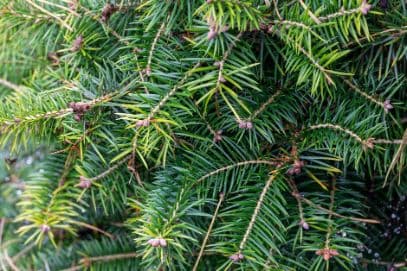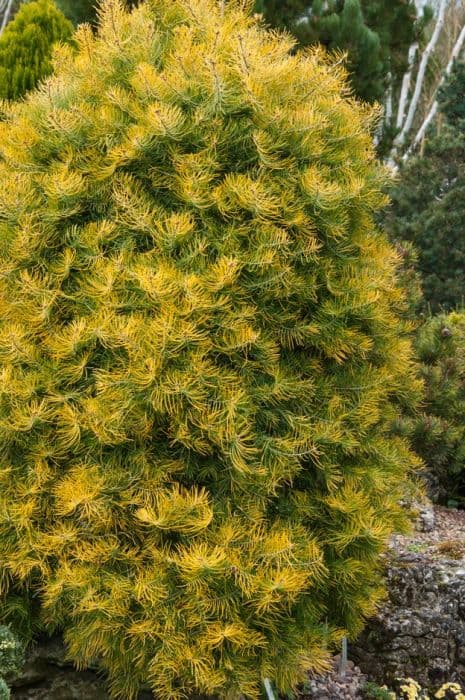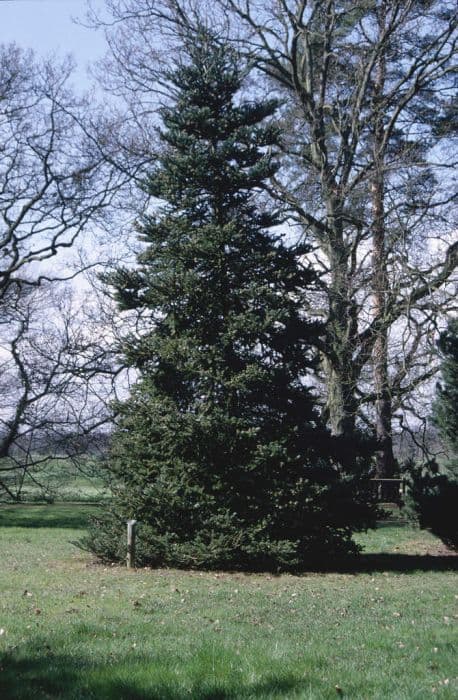Dwarf Mugo Pine Pinus mugo 'Humpy'

ABOUT
The 'Humpy' is a variety of mountain pine known for its dense, compact growth habit, forming a naturally rounded mound. It boasts dark green needles that are arranged in pairs, giving it a full and bushy appearance. The needles have a stiff texture and are typically arranged in a spiral pattern, which contributes to the plant's rich texture. During the growing season, the tips of the branches may display candles, which are new growth shoots that add to the plant's overall visual interest. It bears cones that start out as small and green before maturing to a brown color. These cones are relatively small and may not be as prominently displayed as the foliage. The 'Humpy' mountain pine has a rugged and hardy look, befitting of its alpine heritage, and it can serve as a striking feature in a variety of garden settings, providing year-round interest thanks to its evergreen nature.
About this plant
 Names
NamesFamily
Pinaceae.
Synonyms
Dwarf Mountain Pine, Mugo Pine, Swiss Mountain Pine, Humpy.
Common names
Pinus mugo 'Humpy'.
 Toxicity
ToxicityTo humans
The Mugo Pine is generally not considered toxic to humans. However, ingestion of pine needles can potentially cause mild gastrointestinal irritation, which could result in symptoms like vomiting or diarrhea. There are no significant toxic consequences for humans ingesting parts of Mugo Pine.
To pets
Mugo Pine is also not typically considered toxic to pets. However, if a pet were to ingest a large quantity of pine needles, this could potentially lead to gastrointestinal upset or blockage. Symptoms might include vomiting, diarrhea, abdominal pain, or lethargy. It is always best to discourage pets from chewing on or ingesting any non-food plant material to avoid potential issues.
 Characteristics
CharacteristicsLife cycle
Perennials
Foliage type
Evergreen
Color of leaves
Green
Height
1-2 feet (30-60 cm)
Spread
2-3 feet (60-90 cm)
Plant type
Shrub
Hardiness zones
2-8
Native area
Europe
Benefits
 General Benefits
General Benefits- Compact Growth: P. mugo 'Humpy' has a compact and dense growth habit, making it suitable for small gardens and spaces where a dwarf plant form is desired.
- Low Maintenance: This plant requires minimal pruning and care once established, making it ideal for low-maintenance landscapes.
- Year-Round Interest: With evergreen needles, P. mugo 'Humpy' provides color and texture to the garden throughout the year.
- Cold Hardy: It is capable of withstanding cold temperatures, making it a good choice for gardens in cooler climates.
- Erosion Control: The plant's extensive root system can help stabilize slopes and control erosion.
- Drought Tolerant: Once established, P. mugo 'Humpy' has good drought tolerance, reducing the need for frequent watering.
- Wildlife Habitat: It offers shelter and nesting sites for birds and other wildlife.
- Soil Adaptability: This plant can thrive in a variety of soil types, as long as they are well-draining.
- Windbreak: Because of its dense growth, it can act as a windbreak, protecting more delicate plants and garden areas.
- Aesthetic Appeal: Its unique mounded shape and rich green needles provide aesthetic appeal to a variety of garden styles.
 Medical Properties
Medical PropertiesThis plant is not used for medical purposes.
 Air-purifying Qualities
Air-purifying QualitiesThis plant is not specifically known for air purifying qualities.
 Other Uses
Other Uses- Miniature Landscaping: Due to its dwarf form, Pinus mugo 'Humpy' is often used in miniature and fairy gardens, creating a diminutive forested landscape.
- Bonsai: This plant is suitable for crafting into bonsai forms, given its slow growth rate and compact nature.
- Erosion Control: Pinus mugo 'Humpy' can be used on slopes and in areas susceptible to erosion to help stabilize the soil with its root system.
- Winter Interest: In areas with bleak winters, the evergreen nature of Pinus mugo 'Humpy' provides greenery and visual interest during the cold months.
- Windbreaks in Miniature Scale: In small gardens or terraces, this plant can act as a miniature windbreak or privacy screen.
- Cultural and Artistic Significance: The unique form of Pinus mugo 'Humpy' is used in art and photography to add aesthetic value to compositions and sceneries.
- Collector's Item: Enthusiasts of unique plant cultivars often seek out this plant for its distinctive growth habit, making it a prized collector's item.
- Container Gardening: It is well-suited for growing in containers or above-ground planters due to its compact size and root system.
- Theme Gardens: Pinus mugo 'Humpy' can be incorporated into specific garden themes that focus on alpine or mountain landscapes.
- Education and Research: The Pinus mugo 'Humpy' may be used in educational settings to demonstrate plant adaptation and dwarfism in flora.
Interesting Facts
 Feng Shui
Feng ShuiThe Mugo Pine is not used in Feng Shui practice.
 Plant Symbolism
Plant Symbolism- Resilience: Mugo pine is known for its ability to withstand harsh conditions, symbolizing the capacity to endure challenges and remain steadfast.
- Longevity: As a pine species, mugo pine represents long life and immortality, due to its evergreen nature and long lifespan.
- Peace: Pine trees are often associated with serenity and tranquility, suggesting a sense of calm and peacefulness.
- Healing: Traditionally, pines are thought to have medicinal properties, hence symbolizing healing and health.
- Fertility: The prolific seed production of pines, including mugo pine, is symbolic of fertility and abundance.
- Wisdom: Mugo pine, with its ancient lineage, can allude to wisdom and the accumulation of knowledge over time.
 Water
WaterDwarf Mountain Pine requires watering with consideration to the soil moisture levels rather than on a strict schedule. During the first growing season, water the plant deeply once a week to establish a strong root system, using about 1-2 gallons depending on the size of the plant and weather conditions. Once established, Dwarf Mountain Pine is drought-resistant and typically needs watering every two to three weeks with similar amounts, especially during prolonged dry spells. Always check the top few inches of soil for dryness before watering and reduce frequency during the fall to harden off the plant for winter.
 Light
LightDwarf Mountain Pine thrives best in full sun conditions, meaning it should receive at least six hours of direct sunlight every day. The ideal spot for this plant is an open area where it is exposed to unfiltered, direct sunlight for the majority of the day. Partial shade is tolerated, but the plant's growth and needle coloration are optimal in full sun exposure.
 Temperature
TemperatureDwarf Mountain Pine is a hardy plant that can tolerate a wide range of temperatures; it's suitable for USDA hardiness zones 2 through 8. The plant can survive minimum temperatures down to around -40°F and is comfortable in the high end up to 90°F, although it prefers the cooler conditions typical of mountain environments. Optimal growth occurs in cool to moderate temperature conditions.
 Pruning
PruningPruning of Dwarf Mountain Pine is generally done to maintain its shape, remove damaged branches, or promote denser growth. Pruning should be carried out in late winter or early spring before the onset of new growth. The frequency of pruning depends on the desired shape and size of the plant, but typically once a year is sufficient. Always use clean, sharp tools and make cuts just above a set of needles or branch junction to encourage healthy regrowth.
 Cleaning
CleaningNot needed
 Soil
SoilThe Dwarf Mountain Pine prefers well-draining soil with a pH ranging from 5.5 to 6.5. A suitable soil mix could include one part peat, one part pine bark, and one part coarse sand or perlite. This combination provides good drainage and a slightly acidic environment ideal for the plant’s growth.
 Repotting
RepottingDwarf Mountain Pines like Pinus mugo 'Humpy' should typically be repotted every 2-4 years. Younger plants may require more frequent repotting, but as they mature, the frequency can decrease. It is best to repot in the spring before new growth begins.
 Humidity & Misting
Humidity & MistingDwarf Mountain Pine thrives in outdoor conditions where it can receive fresh air, so humidity is generally not a concern. This plant is adaptable to a wide range of humidity levels typical of outdoor environments.
 Suitable locations
Suitable locationsIndoor
Ensure bright light, cool temp, and good air circulation.
Outdoor
Choose sunny spot, protect from harsh winds, well-drained soil.
Hardiness zone
2-8 USDA
 Life cycle
Life cyclePinus mugo 'Humpy', commonly known as Dwarf Mugo Pine, begins its life with seed germination, occurring in a well-drained soil environment with ample sunlight. Once the seedling emerges, it enters a juvenile phase, developing needle-like leaves and initial root structures over the next several years. As it matures into an adult, it develops a dense, rounded form with a robust root system and starts producing male and female cones following a seasonal cycle. Pollination typically occurs through wind dispersion, with male cones releasing pollen that fertilizes the ovules in female cones. After successful fertilization, female cones mature over a period of months to years, depending on environmental conditions, before they release seeds to start a new generation. Throughout its life, which can span multiple decades, the Dwarf Mugo Pine requires minimal maintenance, withstanding harsh conditions and thriving in rocky, alpine environments.
 Propogation
PropogationPropogation time
Late winter
The dwarf mountain pine, known as Pinus mugo 'Humpy', is commonly propagated through seed collection and sowing, although this can be a challenge due to variability and slow growth. The most popular method of propagation for the dwarf mountain pine is by taking semi-hardwood cuttings. This typically takes place during the late summer, when new growth has begun to mature but is not yet fully hardened. Cuttings about 4 to 6 inches long are taken from the current year's growth. The lower needles are removed, and the cut end may be treated with a rooting hormone to encourage root development. Then, the cuttings are placed in a well-draining rooting medium and kept in high humidity and indirect light until roots have established, which can take several months. Once the cuttings have rooted, they can be transplanted into individual pots or directly into the garden.









